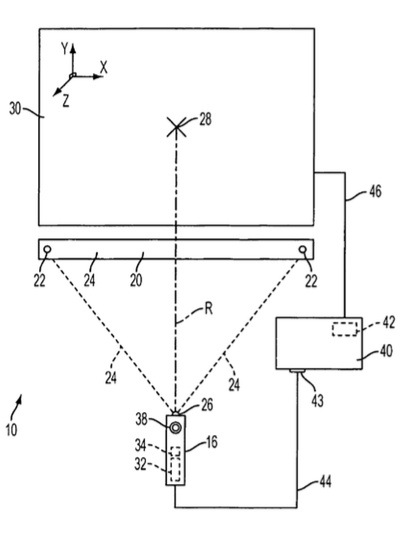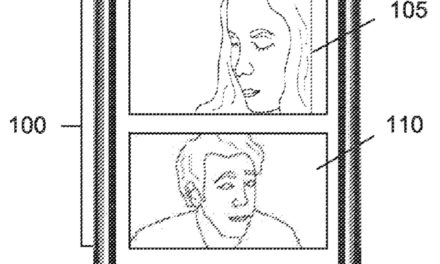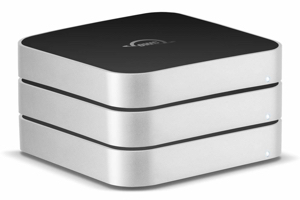Apple has been granted a patent (number 8291346) by the U.S. Patent & Trademark Office for a 3D remote control system employing absolute and relative position detection.
The present invention can include three-dimensional remote control systems that can detect an absolute location to which a remote control is pointing in first and second orthogonal axes and an absolute position of the remote control in a third orthogonal axis. Remote control systems of the present invention can employ absolute position detection with relative position detection.
Absolute position detection can indicate an initial absolute position of the remote control and relative position detection can indicate changes in the position of the remote control. By combining absolute and relative position detection, remote control systems of the present invention can track remote controls more precisely than systems that only employ absolute position detection. The present invention also can include methods and apparatus for zooming in and out of an image shown on a display based on the absolute position of the remote control in the third axis.
Here’s Apple’s background and summary of the invention: “Some electronic systems can permit a user to interact with software applications, e.g., video games, by manipulating a remote control. For example, the systems can permit a user to interact with an image shown on a display by pointing a remote control at desired locations on or proximate to the display.
“Using infrared (IR) sources and photodetectors, the remote control systems can detect light produced or reflected by the light sources. The systems then can determine the location to which the remote control is pointing based on the detected light. The remote control systems or electronic devices coupled thereto can then perform one or more predetermined actions.
“The present invention can include multi-dimensional (e.g., 2-D or 3-D) remote control systems that can detect an absolute location to which a remote control is pointing in first and second orthogonal axes (e.g., the x- and y-axes). Remote control systems of the present invention also can detect the absolute position of the remote control in a third orthogonal axis (e.g., the z-axis).
“To determine the absolute position of the remote control, remote control systems of the present invention can employ absolute position detection with relative position detection. Absolute position detection can indicate an initial absolute position of the remote control. Relative position detection can indicate changes in the position of the remote control.
“When the initial absolute position is combined with a change in the position of the remote control, an updated absolute position can be determined. Because relative position detection can provide greater resolution than some techniques used in absolute position detection, the updated absolute position can be more precise than the initial absolute position determined for the remote control.
“The remote control system of the present invention also can zoom into and out of an image or a portion thereof based on the absolute position of the remote control in the third axis.”
The inventors are Duncan Robert Kerr, Chad Bronstein, Wing Kong Low and Nicholas Vincent King.
Apple has also been granted the following patents:
° Patent D669069 for a portable display device (the iPad).
° Patent number 8291395 is for methods and an apparatus, including computer program products, for locating a function call site in a code segment of a running application, the code segment including a plurality of instructions.
° Patent number 8291320 is for a graphical user interface for browsing, searching and presenting media items.
° Patent number 8291241 is for systems and methods for detecting the connection of a FireWire peer to a FireWire device.
° Patent number 8290546 for a connector for receiving a cylindrical plug includes a body defining a plug aperture and a cavity for receiving the cylindrical plug.
° Patent number 8290513 for methods, systems, and apparatus, including computer program products, for location-based services.
° Patent number 8289813 for devices and systems for outputting contextual information about an event for which an alarm is set on an electronic device.
° Patent number 8289438 for using distance/proximity information when applying a point spread function in a portable media device.
° Patent number 82894333 for a method of managing multiple contexts for a single mode display that includes receiving a plurality of tasks from one or more applications and determining respective contexts for each task, each context having a range of memory addresses.
° Patent D669092 for the ornamental design of a display screen or portion thereof.
° Patent number 8292480 for a method and an apparatus for configuring a key stored within a secure storage area (e.g., ROM) of a device including one of enabling and disabling the key according to a predetermined condition to execute a code image.
° Patent number 8292440 for providing a proxy view for an application in a window manager.
° Patent number 8292395 for methods and apparatus, including computer program products, for locating a function call site in a code segment of a running application, the code segment including a plurality of instructions.
° Patent number 8291332 for an user-activatable dashboard (also referred to as a unified interest layer) contains any number of user interface elements, referred to herein as “widgets,” for quick access by a user.
° Patent number 8291166 for a method for managing data storage.
° Patent number 8290908 for a synchronization server process.
° Patent number 8290434 for a method and apparatus for triggering network device discovery.
° Patent number 8289400 for an image capturing device (the iPhone).
° Patent number 829134 for a device, method and graphical user interface for managing concurrently open software applications. It involves the iOS interface.



![[NPL] sLog 2.0fc1](https://www.mactech.com/wp-content/themes/Extra/images/post-format-thumb-text.svg)

